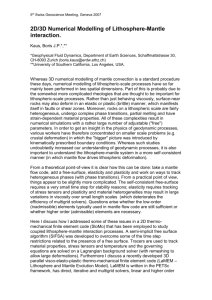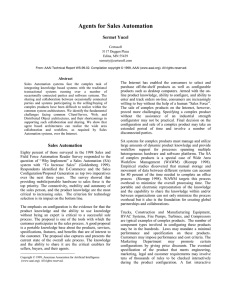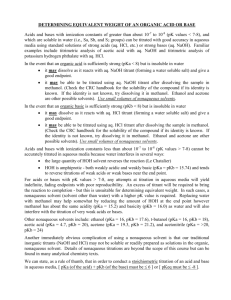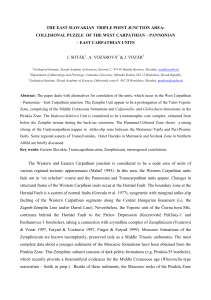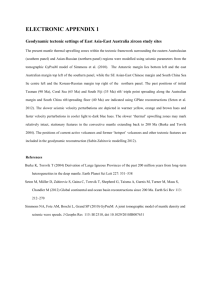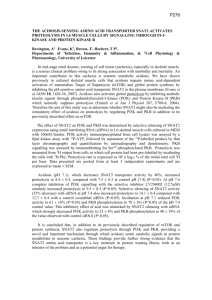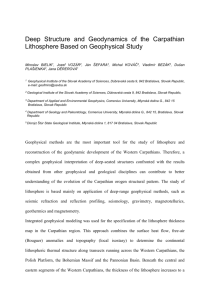wik ciółka
advertisement
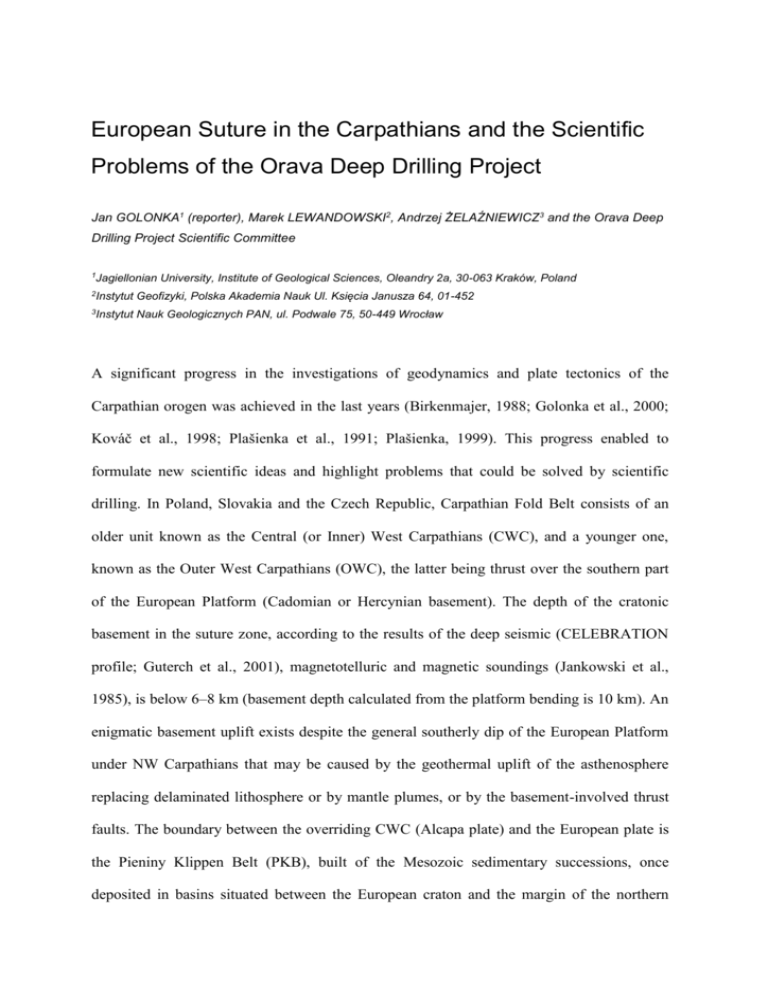
European Suture in the Carpathians and the Scientific Problems of the Orava Deep Drilling Project Jan GOLONKA1 (reporter), Marek LEWANDOWSKI2, Andrzej ŻELAŹNIEWICZ3 and the Orava Deep Drilling Project Scientific Committee 1Jagiellonian 2 University, Institute of Geological Sciences, Oleandry 2a, 30-063 Kraków, Poland Instytut Geofizyki, Polska Akademia Nauk Ul. Księcia Janusza 64, 01-452 3Instytut Nauk Geologicznych PAN, ul. Podwale 75, 50-449 Wrocław A significant progress in the investigations of geodynamics and plate tectonics of the Carpathian orogen was achieved in the last years (Birkenmajer, 1988; Golonka et al., 2000; Kováč et al., 1998; Plašienka et al., 1991; Plašienka, 1999). This progress enabled to formulate new scientific ideas and highlight problems that could be solved by scientific drilling. In Poland, Slovakia and the Czech Republic, Carpathian Fold Belt consists of an older unit known as the Central (or Inner) West Carpathians (CWC), and a younger one, known as the Outer West Carpathians (OWC), the latter being thrust over the southern part of the European Platform (Cadomian or Hercynian basement). The depth of the cratonic basement in the suture zone, according to the results of the deep seismic (CELEBRATION profile; Guterch et al., 2001), magnetotelluric and magnetic soundings (Jankowski et al., 1985), is below 6–8 km (basement depth calculated from the platform bending is 10 km). An enigmatic basement uplift exists despite the general southerly dip of the European Platform under NW Carpathians that may be caused by the geothermal uplift of the asthenosphere replacing delaminated lithosphere or by mantle plumes, or by the basement-involved thrust faults. The boundary between the overriding CWC (Alcapa plate) and the European plate is the Pieniny Klippen Belt (PKB), built of the Mesozoic sedimentary successions, once deposited in basins situated between the European craton and the margin of the northern Africa. At present, the PKB is an almost 700 km long, strongly compressed and tectonically complicated suture zone. In this relatively narrow belt (comprising the PKB and adjacent, still poorly recognized units), there is a wealth of unanswered questions that hamper a better understanding of the evolution of the Central European Alpine system. These questions and problems can be grouped into several disciplinary topics, which combine both regional and continental-scale issues. TOPIC 1. Stuctural position of the PKB within the CFB and its meaning for a reconstruction of the Cenozoic Alpine system of Europe. The PKB, which is one of the most complicated and enigmatic structures within the CFB, is bounded by probably firstorder strike-slip faults both in the north and the south. In-depth structure and geometry of the PKB are unknown. In order to solve fundamental obstacles in the reconstruction of the CFB evolution, the following points need to be addressed: 1. structural relationships between the PKB and adjacent formations; 2. nature of the contact zones, magnitude and relative displacement between contacting units; 3. verification of models, identification of the subduction type (A or B) and direction within the CFB; 4. geometry of the PKB suture at depth; 5. total thickness of the Lower Miocene deposits in the context of the evolution of the foreland basin; 6. identification of the tectonic units beneath the Magura nappes overthrust; 7. paleogeographic disposition of the PKB basins. TOPIC 2. Relationship between geotectonic and geodynamic setting and magmatogenesis. The Flysch Belt, adjacent to the PKB from the north, also contains andesitic Neogene (Sarmatian) volcanic rocks, whose origin is interpreted as a combined effect of the mantle uplift and subduction processes. In effect, extensional regime is exerted within generally compressional stress field, a situation unique within the Alpine system of Europe, with yet not fully recognized impact for the orogen evolution. A temporal and spatial definition of the igneous activity, together with precise geochemical and petrological characteristics of whole rocks and mineral phases is of fundamental importance in order to solve the relative contribution of asthenosphere and lithosophere to the magmatic products emplaced during the Alpine orogeny. Worth note is the presence in the study area of OIBlike (OIB = Ocean Island Basalt) mantle melts with extreme geochemical and isotopic features (e.g., extremely unradiogenic 206 Pb/204Pb and 87 Sr/86Sr, coupled with radiogenic 143 Nd/144Nd and 208 Pb/204Pb) among the Cenozoic European Volcanic Province (CEVP) products (e.g., Alibert et al., 1987; Bluzstain and Hart, 1989; Wilson and Patterson, 2001; Lustrino, 2002). TOPIC 3. Nature of the geophysical anomalies. TOPIC 4. Geothermal issues. TOPIC 5. Geodynamic reconstruction of the Mesozoic–Cenozoic basins. TOPIC 6. Oil generation, migration and timing. TOPIC 7. Regional heat-flow evolution. TOPIC 8. Identification and definition of the Cadomian–Hercynian basement structure of the Carpathians. TOPIC 9. Paleostress evolution and its changes in horizontal and vertical section. All these topics are potential issues to be solved by the drilling. Based on the current stage of knowledge, if the basement of the Alpine orogen is to be reached and the rocks responsible for the anomaly are also to be recognized, the main drilling should reach the depth of 8000 m. Tentatively, we presume that ODDP could be located in the vicinity of the Hyżne village near the Polish–Slovak border to serve both Polish and Slovak scientists and to utilize international cooperation. It would be also situated along the CELEBRATION 2000 deep seismic profile line in the near vicinity of the deep geological cross-sections Kraków– Zakopane and Andrychów–Hyżne, utilizing the series of wells of the Polish Geol. Inst. and Polish Oil Industry. References ALIBERT C., LETERRIER J., PANASIUK M. and ZIMMERMANN J.L., 1987. Trace and isotope geochemistry of the alkaline Tertiary volcanism in southwestern Poland. Lithos, 20: 311-332. BIRKENMAJER K., 1986. Stages of structural evolution of the Pieniny Klippen Belt, Carpathians. Studia Geol. Pol., 88, 7: 32. BLUSZTAJN J. and HART S.R., 1989. Sr, Nd, and Pb isotopic character of Tertiary basalts from southwest Poland. Geochim. Cosmochim. Acta, 53: 2689-2696. GOLONKA J., OSZCZYPKO N. and ŚLĄCZKA A., 2000. Late Carboniferous – Neogene geodynamic evolution and paleogeography of the circum-Carpathian region and adjacent areas. Ann. Soc. Geol. Pol., 70: 107-136. GUTERCH A. et al., 2001. New deep seismic studies of the lithosphere in Central Europe. POLONAISE’97 and CELEBRATION 2000 seismic experiments. Biul. Państw. Inst. Geol., 396: 61. JANKOWSKI J., TARŁOWSKI Z., PRAUS O., PECOVA J. and PETER V., 1985. The results of deep geomagnetic sounding in the west Carpatians. Geoph. J. R.A.S., 80: 561-574. KOVÁČ M. et al., 1998. Palinspastic reconstruction of the Carpathian-Pannonian region during the Miocene. In: M. RAKÚS (Editor), Geodynamic development of the Western Carpathians. Bratislava. LUSTRINO M., MELLUSO L. and MORRA V., 2002. The transition from alkaline to tholeiitic magmas: a case study from the Orosei-Dorgali Pliocene volcanic district (NE Sardinia, Italy). Lithos, 63: 83-113 PLAŠIENKA D., 1999. Tectonochronology and paleotectonic model of the Jurassic – Cretaceous evolution of the Central Western Carpathians. Veda, Bratislava. WILSON M. and PATTERSON R., 2001. Intraplate magmatism related to short-wavelength convective instabilities in the upper mantle: evidence from the Tertiary-Quaternary volcanic province of Western and Central Europe. In: R.E. ERNST and K.L. BUCHAN (Editors), Mantle plumes: their identification through time. Geol. Soc. Am. Spec. Paper, 352: 37-58.


